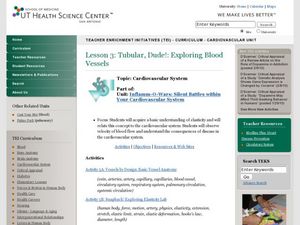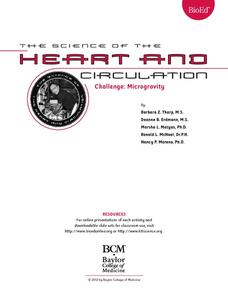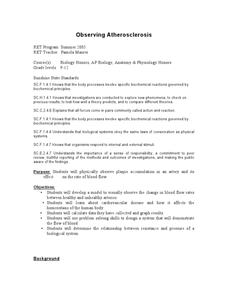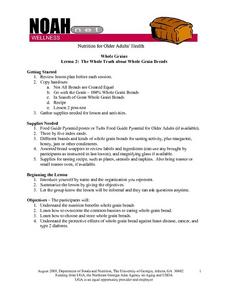Curated OER
The Benthic Drugstore
Students identify at least three pharmacologically- active chemicals derived from marine invertebrates. They describe the disease-fighting action of at least three pharmacologically-active chemicals derived from marine invertebrates.
Curated OER
The Crisco Lab: A Demonstration of Diabetic Complications
Young scholars complete lab activities to illustrate the complications of diabetes. In this diabetes instructional activity, students work on labs that illustrate sugar in the blood and normal and atherosclerotic vessels. They...
Curated OER
Living by the Code
Students explain why new drugs are needed to treat cardiovascular disease, cancer, inflammation, and infections. They infer why some marine invertebrates are promising sources of new drugs, explaining the process in which cells...
Curated OER
Heart Fair
Students demonstrate their knowledge of the heart and heart disease by creating and presenting a project at the annual Heart Fair. They design a booth for the Heart Fair and inform people of how to have and maintain a healthy heart.
Curated OER
Tubular, Dude! Exploring Blood Vessels
Students explore the cardiovascular system. In this human body instructional activity, students observe blood flow and study cardiovascular diseases and how they affect the human body system.
Curated OER
The Beat Goes On
Students take their own pulse before and after exercise as they explore how the heart works. They research various ways that heart disease is treated and suggest specific treatment methods for their own imaginary patients.
Curated OER
Drug Addition Is a Disease. So What Do WE Do About It?
Students make predictions about the success rate for treatment of addiction compared with treatment for other chronic diseases. They evaluate case studies of individuals with different diseases to compare and contrast how the diseases...
Curated OER
Heart Healthy
Students assess their risk of heart disease. In this adult health lesson, students differentiate saturated and unsaturated fats. They discuss different heart healthy food ideas.
Curated OER
Keeping Your Heart in Good Shape: What are the Benefits? - Biology Teaching Thesis
Students name the main parts of the heart and what events occur there. They write a reaction that contains complete sentences, and uses proper spelling and grammar, after viewing a video. Students define the following terms: contraction,...
Baylor College
Examining the Heart
Break hearts with this lesson plan: chicken or sheep hearts, that is! Your class examines the external and internal structure of the heart with a dissection activity. A handy anatomy resource provides the necessary materials for...
Baylor College
Challenge: Microgravity
What a festive way to examine what happens to the heart in different gravitational situations! Small groups place a water-filled balloon in different locations (on a table top, in a tub of water, and held in a vertical position), drawing...
Curated OER
Observing Atherosclerosis
Young scholars develop a model to visually observe the change in blood flow rates between healthy and unhealthy arteries. They calculate data that they have collected and graph their results. They determine the relationships the flow...
Curated OER
Lung Disease
Students simulate breathing for a smoker and someone with a chronic lung disease. In this health science lesson plan, students examine the short and long term effects of smoking. They write a persuasive argument against it.
Curated OER
What Are My Daily Calorie Needs?
Learners explore what their personal nutritional requirements are. In this exploratory lesson students calculate their total daily energy needs and energy outputs and study how age is related to changing this.
National Center for Case Study Teaching in Science
A Healthy Retirement?
Do men and women experience heart disease the same way? High school and college-level biologists examine a case study about a woman, Nancy, who is experiencing intermittent health issues; looking at her diet, exercise, and lifestyle...
NOAA
Microfriends
Is there medicine found in the organisms that live deep below the surface of the ocean? The fifth lesson in a six-part series has learners team up to research bacteria and the relationship it has with nearly every living thing on Earth....
Baylor College
Heart Rate and Exercise
Teach your exercise enthusiasts to read their pulse rate at the radial artery and multiply by four to calculate beats per minute. Learners perform a variety of activities, recording their heart rates after one minute of each. Though this...
Baylor College
The Heart is a Pump
Circulate this news: the heart is a pump containing one-way valves! Following the previous instructional activity on the external structure of the heart, learners now take a look at the inside. They use a three-color diagram to label a...
Baylor College
What is Blood Pressure?
Find out how we describe the force created by the blood against the walls of the vessels in a heart-pumping instructional activity! As part of a unit on the heart and circulatory system, cardiology kids use a blood pressure monitor to...
Curated OER
The Strongest Pump of All
Students examine how the heart functions and the concept of how electrical currents can affect muscle contractions. In this cardiovascular lesson students identify P, QRS and T complexes.
NOAA
Watch the Screen!
Can a sponge cure cancer? Life science pupils visit the drugstore under the sea in the fifth lesson of six. Working groups research the topic then get hands-on experience by testing the inhibiting effects of several plant extracts on E....
Curated OER
Are You Susceptible?
Students play a game to explore the relationship between genetic variation and environmental factors in the onset of heart disease. They consider the implications for disease prevention of increased knowledge about genetic variation.
Curated OER
The Whole Trut about Whole Grain Breads
Students comprehend the nutrition benefits whole grain breads. They explore how to overcome the common barriers to eating whole grain bread. Students investigate how to choose and store whole grain breads. They comprehend the...
Curated OER
Science In Society
Fifth graders study diseases that are related to the use of alcohol, tobacco, and drugs, both prescription and illegal. They determine illnesses that can occur as a direct result of the use of or inappropriate use of these substances....

























